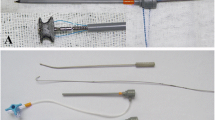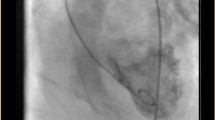Abstract
With the development of interventional techniques and devices, transcatheter closure of perimembranous ventricular septal defect has been widely performed. However, there has been a lack of long-term follow-up results about postoperative ECG changes of PmVSD patients. We report our experience of early and late arrhythmias after transcatheter closure of PmVSD with a modified double-disk occluder (MDVO). We performed a retrospective review of 79 patients (47 males, 32 females) between September 2002 and May 2007 who underwent transcatheter closure of perimembranous ventricular septal defect. Symmetric and asymmetric PmVSD occluders were used. The diameter of the evaluated defects ranged from 3 to 12 mm, as measured by TTE and 3 to 15 mm by left ventriculography. Most cases of PmVSD were treated successfully with a single procedure, resulting in a successful closure rate of 97% (77/79 patients). There was no death in any of the patients. After the operation, 79 patients were followed-up for a range of 10–76 months (35.3 ± 17.4 months). In this series, 11 cases of incomplete right bundle branch block and five cases of complete right bundle branch block occurred during the early period after operation. During long-term follow-up, these issues declined in prevalence to five and four cases, respectively. Moreover, reversible third-degree AVB occurred during closure or after the procedure, and two of the three patients with reversible AVB received a temporary heart pacemaker implantation. These patients recovered 1 h, 6 days, and 9 days later, respectively. During 10–76 months of follow-up, no complications occurred in any of the patients, including residual shunt, severe aortic valve, or tricuspid valve regurgitation. Device closure of perimembranous ventricular septal defects with a modified double-disk occluder (MDVO) resulted in excellent closure rates and acceptably low arrhythmia rates.


Similar content being viewed by others
References
Mavroudis C, Backer CL, Jacobs JP (2003) Ventricular septal defect. In: Pediatric cardiac surgery, 3rd edn. Mosby, Philadelphia, pp 298–320
Masutani S, Taketazu M, Ishido H, Iwamoto Y, Yoshiba S, Matsunaga T, Kobayashi T, Senzaki H (2011) Effects of age on hemodynamic changes after transcatheter closure of atrial septal defect: importance of ventricular diastolic function. Heart Vessels. doi:10.1007/s00380-011-0122-8
Oses P, Hugues N, Dahdah N, Vobecky SJ, Miro J, Pellerin M, Poirier NC (2010) Treatment of isolated ventricular septal defects in children: Amplatzer versus surgical closure. Ann Thorac Surg 90:1593–1598
Gu MB, You XH, Zhao XX, Zheng X, Qin YW (2011) Transcatheter device closure of intracristal ventricular septal defects. Am J Cardiol 107:110–113
Holzer R, de Giovanni J, Walsh KP, Tometzki A, Goh T, Hakim F, Zabal C, de Lezo JS, Cao QL, Hijazi ZM (2006) Transcatheter closure of perimembranous ventricular septal defects using the Amplatzer membranous VSD occluder: immediate and mid-term results of an international registry. Catheter Cardiovasc Interv 68:620–628
Shih CH, Liang PC, Chiang FT, Tseng CD, Tseng YZ (2010) Transcatheter embolization of a huge renal arteriovenous fistula with Amplatzer Vascular Plug. Heart Vessels 25:356–358
Butera G, Chessa M, Carminati M (2007) Percutaneous closure of ventricular septal defects. Cardiol Young 17:243–253
Masura J, Gao W, Gavora P, Sun K, Zhou AQ, Jiang S, Ting-Liang L, Wang Y (2005) Percutaneous closure of perimembranous ventricular septal defects with the eccentric Amplatzer device: multicenter follow-up study. Pediatr Cardiol 26:216–219
Holzer RJ, Balzer D, Cao QL, Lock K, Hijazi ZM (2004) Device closure of muscular ventricular septal defects using the Amplatzer muscular VSD occluder: immediate and midterm results of a US registry. J Am Coll Cardiol 43:1257–1263
Jian-Jun G, Xue-Gong S, Ru-Yuan Z, Min L, Sheng-Lin G, Shi-Bing Z, Qing-Yun G (2006) Ventricular septal defect closure in right coronary cusp prolapse and aortic regurgitation complicating VSD in the outlet septum: which treatment is most appropriate? Heart Lung Circ 15:168–171
Wu H, Qin YW, Zhao XX, Hu JQ, Zheng X, Wang ES, Li WP, Wang YY, Liu B, Liu J, Wang SQ (2009) Transcatheter closure of multi-hole perimembranous VSD with aneurysm: 3-year follow-up study. Clin Res Cardiol 98:563–569
Butera G, Chessa M, Carminati M (2007) Transcatheter closure of perimembranous ventricular septal defects: early and long-term results. J Am Coll Cardiol 50:1189–1195
Pinto RJ, Dalvi BV, Sharma S (2006) Transcatheter closure of perimembranous ventricular septal defects using the Amplatzer asymmetric ventricular septal defect occluder: preliminary experience with 18-month follow-up. Catheter Cardiovasc Interv 68:145–152
Qin YW, Chen JM, Zhao XX, Liao D, Mu R, Wang S, Wu H, Guo H (2008) Transcatheter closure of perimembranous ventricular septal defect using a modified double-disk occluder. Am J Cardiol 101:1781–1786
Predescu D, Chaturvedi RR, Friedberg MK (2008) Complete heart block associated with device closure of perimembranous ventricular septal defects. J Thorac Cardiovasc Surg 136:1223–1229
Author information
Authors and Affiliations
Corresponding author
Rights and permissions
About this article
Cite this article
Li, P., Zhao, Xx., Zheng, X. et al. Arrhythmias after transcatheter closure of perimembranous ventricular septal defects with a modified double-disk occluder: early and long-term results. Heart Vessels 27, 405–410 (2012). https://doi.org/10.1007/s00380-011-0155-z
Received:
Accepted:
Published:
Issue Date:
DOI: https://doi.org/10.1007/s00380-011-0155-z




